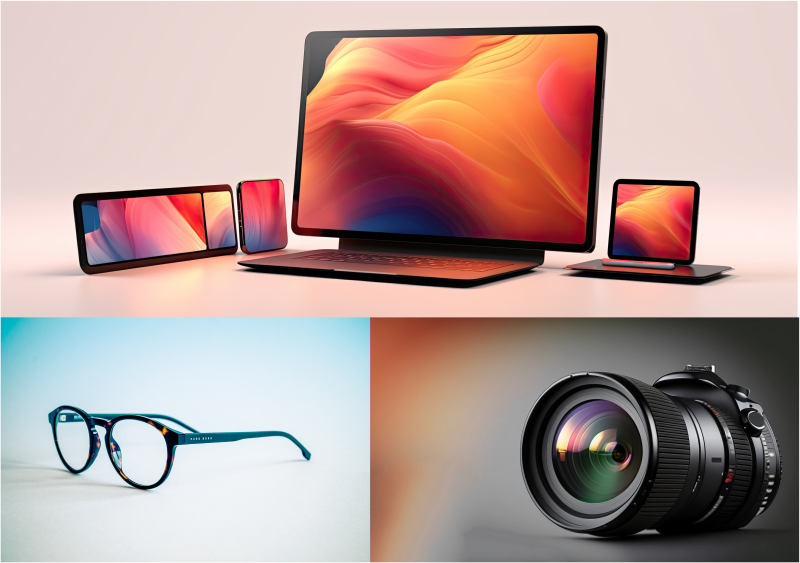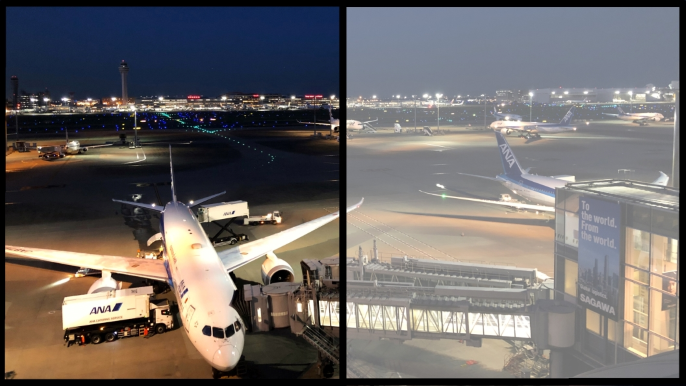What is AR Coating? Explanation of the difference from AG Coating (Anti-Glare Treatment)
AR coating, where AR stands for Anti-Reflection, is a technology that involves applying an anti-reflection layer onto a film or another substrate. This layer helps to reduce reflected light, thereby minimizing surface reflections and glare on the screen. By coating a thin film layer onto the surface of the substrate, it becomes possible to incorporate various additional functions.

*The above information is as of December, 2023.
- Applications of AR coating
- What is AR coating?
- AR coating materials and methods
- Difference between AR coating and AG coating
- DNP for development and manufacture of AR film
Applications of AR coating

|
|---|
AR coatings are commonly used on the top surfaces of LCD and OLED displays in TVs and PCs, as well as on touch panel displays of tablets and smartphones. In addition to displays, AR coatings are also applied to display cases, window glass, eyeglasses, camera lenses, and automobile instrument panels. Due to their placement on the uppermost surfaces, these products require functionalities such as scratch resistance, chemical resistance, and stain resistance.
What is AR coating?

|
|---|
In order to reduce reflected light by utilizing light interference, it is essential to engineer the material in a way that ensures the light reflected on the surface of the anti-reflection layer and the light transmitted through the anti-reflection layer, reflecting at the interface between the anti-reflection layer and the substrate, have the same amplitude but opposite phase. Therefore, the thickness of the AR layer is typically designed to be around 100 nm.
Moreover, variations in the coating thickness will result in changes in reflectance and color. Achieving a consistent coating of a 100 nm thin film requires the development of an ink suitable for thin film coating and the implementation of precise coating technology for the coating solution. There are various methods for thin film coating, with reverse coating, gravure coating, and die coating being the three most common techniques.
AR coating materials and methods
AR coatings provide not only low reflection but also anti-scratch and anti-fouling functionalities to the substrate. Various inorganic and organic materials are used to impart these functions.
The following methods are employed for the application of these materials:
Wet coating method
A coating solution containing particles and resin mixed with water or solvent is applied onto the substrate surface and allowed to dry, resulting in the formation of a thin film.
Vacuum evaporation method
A vacuum is created in a chamber that houses the substrate and coating material. The coating material is heated to evaporate (vaporize) and create a thin film on the substrate.
Sputtering and CVD (Chemical Vapor Deposition) method
Both methods involve creating a vacuum in a chamber containing the substrate. The coating material is deposited on the substrate surface to form a thin film. In the sputtering method, particles are generated by irradiating a target substance, which then deposit on the substrate surface. In CVD, gaseous or liquid materials are supplied, and a chemical reaction occurs to generate a thin film.
DNP's AR coating
DNP has developed a variety of materials such as particles, resins, and additives, with the aim of achieving optimal hardness and refractive index. By carefully combining these materials, the functionality of the film is maximized.
In addition, DNP specializes in "wet coating technology" within the field of AR coating technologies. This method allows for continuous production, enabling the cost-effective manufacturing of films in large quantities compared to other methods. DNP also fine-tunes the physical properties of the ink, including viscosity and surface tension, to ensure precise application of the coating liquid through the wet coating method.
Difference between AR coating and AG coating
What is AG coating (Anti-Glare treatment)?
AG Coating (AG: Anti-Glare) is designed to achieve a similar effect to AR coating. It involves applying a hard coat layer with particles arranged on the surface of the base film to create surface irregularities. These irregularities cause incident light to undergo diffuse reflection, reducing external light reflections. The main difference between AG coating and AR coating lies in the mechanism of light interaction. AG coating relies on the diffuse reflection of light, while AR coating relies on the interference of light.
Difference from AR coating
AR coatings rely on light interference, requiring the AR layer to have a thickness of approximately 100 nm. On the other hand, AG coatings require a film thickness of several micrometers to achieve the desired scattering properties and hardness, which is significantly different from the AR layer. Inorganic and organic particles are blended into the AG layer applied on the surface of the base film, and the ink composition differs significantly from that of AR coatings.
Due to the substantial differences in film thickness and ink design between AR and AG coatings, it is crucial to choose the appropriate coating method for each layer.
Combination of AG coating and AR coating
It is also possible to manufacture AG-AR films that combine both AG and AR coatings. This integration of the two coating technologies allows for a more significant reduction in external light reflection and enhances overall film performance. In such cases, the process involves initially applying AG coating to the base film, allowing it to dry, and then applying AR coating on top.
DNP's coating technologies
DNP formulates its proprietary ink materials specifically designed for the material and optical properties required for both AG coating and AR coating. By using the appropriate coating method, ink, and drying conditions for each type of coating, it is possible to adjust the film thickness from nanometers to micrometers.
DNP for development and manufacture of AR film
At DNP, we have a wealth of expertise in AR film design and manufacturing. Please feel free to contact us for AR film development and manufacturing services. With DNP, we can provide various proposals to meet your specific needs.
Other columns and featured articles
-
What is Retardation Film?|Explaining Principles an...
- Display Components

Retardation films are optical components designed to enhance the contrast and expand the viewing ang...
-
DNP's Display Enhancement Films: AR, AG & Reta...
- Display Components

We will elucidate the principles and applications of DNP's display enhancement films, including AR f...